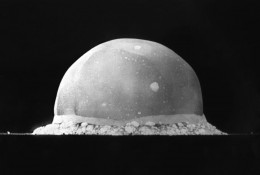Would a powerful non-nuclear explosion look the same as an equivalent nuclear ex
Would a powerful non-nuclear explosion look the same as an equivalent nuclear explosion?
The British used 450 tons of explosive in a series of mines under the German lines. If they had packed in 20,000 tons, the equivalent of the first atomic test, would the result have looked like the blast at Trinity?
The major differences between a nuclear and non-nuclear explosion are that the nuclear explosion creates ionising radiation and fallout and effectively emanates from a point source as compared to a non-nuclear one.
I think that if the two explosions had the same energy they would look different because of the larger space occupied by the conventional explosive. I am not sure of the details of appearance but I think the cloud would be broader and fatter.Even a smaller amount of explosives when blown up will look exactly like nuclear explosion. The question just in size of the "mushroom", I think.... But i never saw anything like that to compare

I heard a report that when the Americans used a Fuel Air Explosive over a bunker complex during the Gulf War of 1990, some British ground troops actually thought it was a small nuclear device due to the mushroom cloud that appeared overhead. I don't remember where I heard that though, unfortunately!
It depends what you mean by "look like". The forces in a nuclear explosion, especially one caused by a modern, advanced device are physically bizarre, and so are nothing like a conventional detonation, no matter what the kiloton yield. These devices cause a fission-fusion-fission reaction (or worse) and have strange effects on the point where matter and energy meet.
Do they look similar to the naked eye? Possibly, but that's where their similarity ends.
Related Discussions
- 1
What are your thoughts on Octanitrocubane?
by Anna O'Malley 11 years ago
What are your thoughts on Octanitrocubane?Octanitrocubane is a powerful explosive that is shock insensitive (you can hit it with a hammer without detonation) , and has the potential to be the most powerful non-nuclear explosive if it can be synthesized in larger quantities at a cheaper price.
- 26
Questions about Evolution
by janesix 10 years ago
I have some questions about evolution.1. Random Mutation. Is it really random?"To determine how the bacteria had gained their tails, Dr. Xavier and his colleagues sequenced the DNA of 24 lines of hyperswarmers. In 24 out of 24 cases, they discovered that they have gained a mutation in the same...
- 3
What is an equivalent fraction for 3/4
by Jessica Monroe 13 years ago
What is an equivalent fraction for 3/4
- 5
Would you buy organic food if it cost the same as non-organic food?
by rlleon42 12 years ago
Would you buy organic food if it cost the same as non-organic food?
- 11
In light of the West Texas explosion, do you live in fear of installations near
by Mary's Crumbs 12 years ago
In light of the West Texas explosion, do you live in fear of installations near your home?Refineries, fertilizer plants, chemical plants, nuclear power plants... it is almost impossible not to have such a potentially dangerous facility nearby. Does living in proximity to such places worry...
- 8
Can one be an amazing mom and a great business/powerful woman at the same time?
by Joana e Bruno 12 years ago
Can one be an amazing mom and a great business/powerful woman at the same time?Or one excludes the other?










